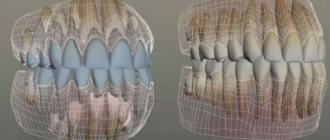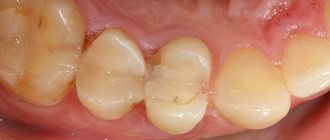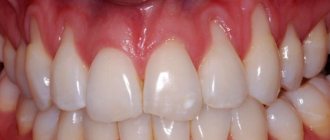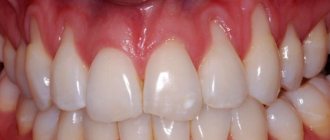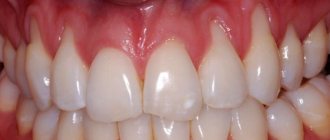Dentist's fault and inflammatory processes in the oral cavity
One of the most common reasons for a large gap to appear is a medical error. This can happen due to the crown fitting too tightly to the soft tissue or, conversely, if the installation of the structure is insufficiently strong.
However, a large gap does not always appear due to the doctor’s fault. Sometimes the reason for this is the presence of serious inflammatory processes, for example on the interdental papillae, in the gums or in the tissues that surround the tooth itself. Quite often, complications appear against the background of a general deterioration in a person’s health and when the functioning of his immune system is disrupted.
Other reasons: insufficient oral hygiene, as well as allergic reactions to the drugs and materials used in the work of the master. If the tightness is broken and the strength of the crown fixation decreases, visible gaps may also form over time. In any case, the situation requires immediate intervention by qualified medical personnel.
Lack of flush hole: consequences
In the absence of a flushing space, the consequences may be as follows:
- inflammatory processes caused by constant contact of mucous membranes with the prosthesis;
- tissue damage with subsequent exposure to pathogens;
- tissue hypertrophy in the affected areas of soft tissue.
If you look at it from a different angle, the rinsing space provokes the penetration of food into the area between the prosthesis and the mucous membrane. But without this gap, the patient will not be able to provide proper oral care. Plaque can accumulate under the bridge, so this area needs more thorough cleaning.
If the patient notes that food debris has entered the resulting space, this may be caused by incorrect installation of the prosthesis, poor quality of construction, or the development of pathologies of the oral cavity. Normally, this situation should not exist.
Splitting, decementing, periodontitis
Even if the bridge is slightly damaged in the place where it comes into contact with artificial prostheses, its position will certainly change over time. This will cause the crown to injure the surrounding soft tissue.
Disintegration of a free-standing crown often occurs. This is also possible in case of negligence of the treating dentist or due to a large amount of salivary fluid getting under the crown. Possible reasons include insufficient preparation of the oral cavity for the installation of crowns.
Before fixation, the doctor must sanitize the teeth and gums; if this is not done in time, bacteria may remain on the surface of the teeth. As a result, periodontal disease or periodontitis may develop. These diseases are characterized by a gradual change in the location of the affected units, which can also lead to an increase in the gap between the crown and the gum. The patient's attempts to clean his teeth using toothpicks and hard brushes are also provoking factors.
PREVENTION MEASURES
To prevent problems with the crown from occurring, the patient must strictly follow the medical recommendations that are communicated to him immediately after the prosthetic procedure:
- perform high-quality hygienic care for the product, organs and tissues of the oral cavity at least 2 times a day;
- Use herbal rinses and dental hygiene devices for additional cleansing 3 times a week;
- periodically visit the attending physician for a preventive examination, monitoring the condition of the structure, and its professional cleansing of food particles;
- use a special dental brush to remove the smallest food residues after each meal;
- use wound-healing pastes for prevention if the slightest discomfort occurs (especially during the period of adaptation);
- purchase an adhesive base to cover the space between the crown and gum tissue (only on the advice of a doctor);
- use a special mouth guard with a cleaning agent, which is placed in the area of the prosthesis to lighten its shade and provide antiseptic treatment;
- limit or completely eliminate coarse salt, poppy seeds, shortcrust pastries, crackers from the diet;
- come to the clinic in a timely manner to make adjustments to the parameters of the orthopedic product in order to prevent the risk of device displacement and widening of the irrigation gap.
Forbidden:
- use a stiff toothbrush;
- apply floss around the neck of the tooth with a crown installed (an irrigator is recommended to clean such places);
- use hard and sharp auxiliary tools (match, needle, sliver, etc.).
Preventive measures must be carried out conscientiously by the patient. Not only the health of the oral cavity and the body as a whole, but also the lifespan of the crown will depend on the quality of care.
Category: Tooth extraction Published by Mister stomatolog
Symptoms
The normal size of the flushing gap is no more than one millimeter. When the prosthesis is installed correctly, it helps to increase the degree of its fixation, improve oral hygiene, protect against many pathological processes and extend the service life of the structure.
Causes for concern may be the appearance of significant discomfort and pain, a strong change in the location of the crown, increased sensitivity to various irritating factors, for example, cold or hot food. Also, if the situation worsens, a person may complain of itching and a burning sensation, impaired diction, whistling when speaking, etc.
All of these symptoms can be localized both at the site where the crown is installed and far beyond it. It is very important to immediately seek advice from your doctor when you notice the first signs of a deviation from the norm. If there is a suspicion that the problem arose due to the lack of qualifications of the specialist, it makes sense to visit another clinic.
POSSIBLE COMPLICATIONS
If you ignore the problems that have arisen and do not visit a doctor in time for an examination, as well as to identify the causes of the gap, the patient risks encountering serious troubles and complications, namely:
- development of complex inflammation in periodontal tissues;
- sudden dismantling of the entire structure;
- destructive diseases of the units located under the crowns;
- allergy attacks to prosthetic material;
- complete breakdown of the device in the area adjacent to the crowns;
- the appearance of excessive galvanic currents in the oral cavity;
- increase in electrical conductivity of saliva;
- the appearance of signs of inflammation of the mucous membrane;
- relapses of carious processes;
- development of general symptoms of unwellness of the body;
- erosive and ulcerative lesions of the mucous membrane;
- atrophy of the tissues holding the tooth in the alveolus.
Take into account! If, after installing a crown, you are constantly bothered by painful sensations in the mouth for more than 7 days, the crown periodically moves, senesthopathy, burning, tingling in a certain area appears, the sensitivity of the teeth to irritating foods increases, you cannot do without medical help.
Moreover, the listed manifestations can be localized not only in the area of the installed device.
Another important danger that can arise after prosthetics is the penetration of the prosthesis into the digestive system after unexpected release.
Despite the fact that such products are made from non-toxic raw materials, the risk of damage to internal organs remains. Let's consider the most serious consequences, which, although rare, occur in medical practice:
- perforation of the walls of the digestive tract;
- trauma to the stomach or intestines with subsequent bleeding;
- intestinal obstruction if the swallowed product has formed an obstruction with its body.
In such cases, it is very important to immediately go to the hospital or call an ambulance. An acute clinical picture of this nature requires examination by a surgeon, gastroenterologist, or emergency transportation of the patient to the nearest emergency room.
Treatment
If a specialist has diagnosed a strong increase in the size of the gap between the crown and the gum, he must prescribe appropriate treatment. First of all, treatment can be carried out with special antiseptic and anti-inflammatory agents. They can be in the form of gel, ointments, etc. The prosthesis must first be removed.
After this, the specialist adjusts the structure; this may require changing its size and shape. In rare cases, it may be decided that a new system needs to be manufactured. Most often this is true when the prosthesis comes off completely, which in itself is a rather rare complication.
Depending on the results of the examination and orthopantomogram, the orthopedist can adjust the size of the crown right in his office or send the product to a dental laboratory. The course of action will depend on the specific clinical picture and complaints of the person seeking help.
previous post
Is it possible to remove and treat a tooth at the same time?
next entry
How the gum bed for an implant crown is formed
During implantation there is a need to form soft tissues. For this, a shaper is used. The design is necessary to create the correct gingival contour, on which the final aesthetic result will depend.
The forming element has the form of a threaded screw equipped with a cylindrical head. Made from hypoallergenic metal. Installed after complete engraftment of the titanium rod. Designed to create a recess around the future crown. This will allow the artificial tooth to fit tightly .
Reasons for loosening of the crown on an implant
If the crown is fixed to the adapter (abutment) with cement, then the most common reason for loosening is poor quality of the material. With screw fastening, the prosthesis is fixed with special screws onto the implant, which acts as a root. This method is considered more reliable compared to cement fixation. But the fastening is subject to load from different sides and the screw may loosen.
The doctor can easily strengthen a loose crown simply by tightening the screw. Screw fastening is more expensive, but as a result, the crown does not have to be replaced every time it becomes loose. The dentist can better see the progress of implant healing and work with screw-based dentures much easier.
What to do if the crown on the implant is loose? You must consult a doctor immediately. This may be a symptom of implant rejection or inflammation of the tissue around it. In such cases, special treatment is necessary.
What to do if the tooth under the crown has completely rotted
It happens that a tooth rots because the crown was initially installed on a defective stump. And sometimes the person himself is to blame for this development of events, because he delayed contacting the doctor.
If the tooth has at least its roots preserved, it is possible to restore the tooth with a special device - a stump insert. The structure is made of ceramic or metal and has branches according to the number of roots. These processes are fixed in the root canals to a third of their depth. The top of the stump tab is intended to strengthen the crown on it.
Often gold or silver is used to cast the stump insert. The first material is preferable because it shines through the crown with a warm yellow color. This shade is similar to the color of natural enamel and is not perceived as foreign. The silver tab has antibacterial properties, but the cold shade affects the visual pigmentation of the gums. This will bother the patient, especially if the tooth is located in the front.
If the roots are rotten, the stump insert will not hold in them. The remaining tooth is removed and restored with an implant or prosthetics.
If the adjacent teeth, which will play the role of supporting teeth, are preserved, it is possible to install a fixed bridge prosthesis. Removable dentures are also common: nylon, acrylic. Here you will have to focus on the amount that the patient is able to pay for this or that method of dental restoration, and the aesthetics that he prefers. During the consultation, the doctor will offer to look at the options for finished products in the photo, and the person will choose the appropriate type of product.
Prosthetics with metal-ceramic crowns
These crowns are the most durable and most aesthetic material used in prosthetics. Crowns completely imitate the appearance of your teeth and restore their functions. Due to the fact that our clinic has its own laboratory, we can achieve excellent aesthetic results, and, importantly, we reduce the time required for prosthetics (on average, a metal-ceramic prosthesis for 3 units is made in 5 days). During the fabrication of the prosthesis, you use a temporary plastic prosthesis. Much depends on the mass used in the laboratory. Here we use the German Vita Omega mass, which we are 100% confident in.
